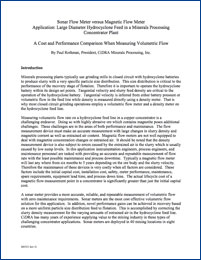Sonar Flow Meter versus Magnetic Flow Meter
Sonar Flow Meter versus Magnetic Flow Meter
Application: Large Diameter Hydrocyclone Feed in a Minerals Processing Concentrator Plant -- A Cost and Performance Comparison When Measuring Volumetric Flow
Minerals processing plants typically use grinding mills in closed circuit with hydrocyclone batteries to produce slurry with a very specific particle size distribution. This size distribution is critical to the performance of the recovery stage of flotation. Therefore it is important to operate the hydrocyclone battery within its design set points. Tangential velocity and slurry feed density are critical to the operation of the hydrocyclone battery. Tangential velocity is inferred from either battery pressure or volumetric flow in the feed line while density is measured directly using a density meter. That is why most closed circuit grinding operations employ a volumetric flow meter and a density meter on the hydrocyclone feed line.
Measuring volumetric flow rate on a hydrocyclone feed line in a copper concentrator is a challenging endeavor. Doing so with highly abrasive ore which contains magnetite poses additional challenges. These challenges are in the areas of both performance and maintenance. The flow measurement device must make an accurate measurement with large changes in slurry density and magnetite content as well as entrained air content. Magnetic flow meters are not well equipped to deal with magnetite concentration changes or entrained air. It should be noted that the density measurement device is also subject to errors caused by the entrained air in the slurry which is usually caused by low sump levels. In this application instrumentation engineers, process engineers, and maintenance personnel are tasked with providing an accurate and repeatable measurement of flow rate with the least possible maintenance and process downtime. Typically a magnetic flow meter will last any where from six months to 5 years depending on the ore body and the slurry velocity. Therefore the maintenance of these devices is very costly when all factors are considered. These factors include the initial capital cost, installation cost, safety, meter performance, maintenance, spare requirements, equipment lead time, and process down time. The actual lifecycle cost of a magnetic flow measurement point in a concentrator is significantly greater than just the initial capital cost.
A sonar meter provides a more accurate, reliable, and repeatable measurement of volumetric flow with zero maintenance requirements. Sonar meters are the most cost effective volumetric flow solution for this application. In addition, novel performance gains can be achieved in recovery based on a more uniform particle size distribution feed to flotation. This is accomplished by correcting the slurry density measurement for the varying amounts of entrained air in the hydrocyclone feed line. CiDRA has many years of experience supplying value to the mining industry in these types of challenging concentrator applications. Sonar meters are deployed in 40 mining locations in eight countries.

